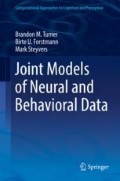Abstract
In this final chapter, we discuss how Marr’s levels of analysis are related to the concept of the linking function. We also discuss how various types of joint models can be used to related different levels of analysis to one consistent and overarching interpretation of brain function.
Access this chapter
Tax calculation will be finalised at checkout
Purchases are for personal use only
References
B.U. Forstmann, E.J. Wagenmakers, T. Eichele, S. Brown, J.T. Serences, Trends Cogn. Sci. 15, 272 (2011)
J.D. Schall, Annu. Rev. Psychol. 55, 23 (2004)
B.C. Love, Top. Cogn. Sci. 7 (2015)
S. Brown, A. Heathcote, Cogn. Psychol. 57, 153 (2008)
M. Usher, J.L. McClelland, Psycholog. Rev. 108, 550 (2001)
B.M. Turner, T. Wang, E. Merkel, NeuroImage 153, 28 (2017)
B.M. Turner, P.B. Sederberg, Psychon. Bull. Rev. 21, 227 (2014)
B.M. Turner, P.B. Sederberg, J.L. McClelland, J. Math. Psychol. 72, 191 (2016)
D. Marr, Vision: A Computational Investigation into the Human Representation and Processing of Visual Information (Freeman, New York, 1982)
J.R. Anderson, The Adaptive Character of Thought (Psychology Press, 1990)
M. Jones, B. Love, Behav. Brain Sci. 34, 169 (2011)
J. Busemeyer, J. Townsend, Z. Wang, A. Eidels, Mathematical and Computational Models of Cognition (Oxford University Press, 2013)
P. Dayan, L. Abbott, Theoretical Neuroscience: Computational and Mathematical Modeling of Neural Systems (MIT Press, Cambridge, 2005)
M.N. Shadlen, W.T. Newsome, J. Neurophysiol. 86, 1916 (2001)
S. Brown, A. Heathcote, Psychol. Rev. 112, 117 (2005)
R. Ratcliff, F. Tuerlinckx, Psychon. Bull. Rev. 9, 438 (2002)
B.M. Turner, T. Van Zandt, Psychometrika 79, 185 (2014)
B.U. Forstmann, E.J. Wagenmakers, An Introduction to Model-Based Cognitive Neuroscience (Springer, New York, 2015)
Author information
Authors and Affiliations
Rights and permissions
Copyright information
© 2019 Springer Nature Switzerland AG
About this chapter
Cite this chapter
Turner, B.M., Forstmann, B.U., Steyvers, M. (2019). Conclusions. In: Joint Models of Neural and Behavioral Data. Computational Approaches to Cognition and Perception. Springer, Cham. https://doi.org/10.1007/978-3-030-03688-1_7
Download citation
DOI: https://doi.org/10.1007/978-3-030-03688-1_7
Published:
Publisher Name: Springer, Cham
Print ISBN: 978-3-030-03687-4
Online ISBN: 978-3-030-03688-1
eBook Packages: Behavioral Science and PsychologyBehavioral Science and Psychology (R0)

